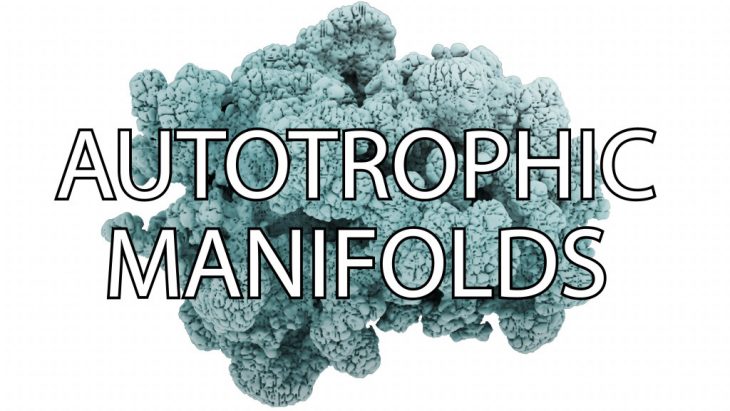
Autotrophic Manifolds represent complex microbial systems for environmental utilization and remediation through self-regulating bacterial metabolisms and communities.The project operates at the intersection of scientific investigation, digital exploration and advanced fabrication with the aim of proposing a system that uses microbial ecologies as a response to contemporary environmental problems such as land/water contamination as a result of man-made activities.
01.ENVIRONMENTAL CONTEXT | LAND/WATER CONTAMINATION
Following over 200 years of industrialization, soil contamination is a widespread problem in Europe. The most frequent contaminants are heavy metals and mineral oil. According to estimates by the European Environment Agency (EEA, 2007), the number of sites where potential polluting activities have been carried out in the EU is approximately three million and, of these, an estimated 250,000 sites may need urgent remediation. The main causes of contamination are past and present industrial and commercial activities, and the disposal and treatment of waste.
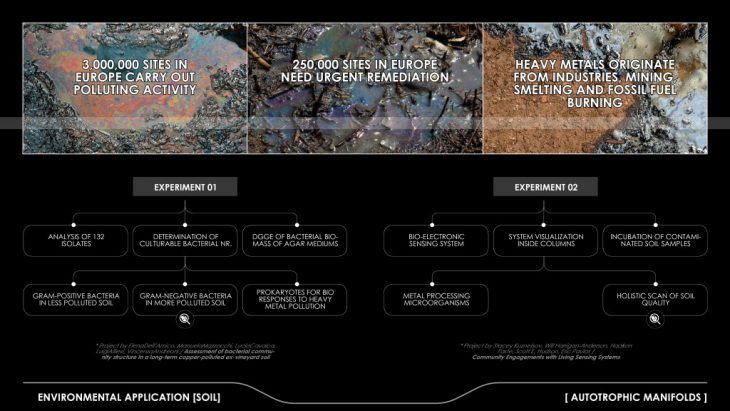
Case Study 1: Shurakhany, Baku/Azerbaijan
Azerbaijan is one of the birthplaces of the industry. The petroleum industry in Azerbaijan produces about 873,260 barrels (138,837 m3) of oil per day and 29 billion cubic meters of gas per year as of 2013.By 1901, Baku produced more than half of the world’s oil (11 million tons or 212,000 barrels (33,700 m3) of oil per day), and 55% of all Russian oil. Approximately 1.2 million tons of Baku kerosene were also sold abroad.The main oil-producing regions were located near Baku at Sabunchy, Surakhany and Bibi-Heybat.Azerbaijan is rich in mineral resources, mainly oil and natural gas but also in iron ore, nonferrous metals, bauxite.
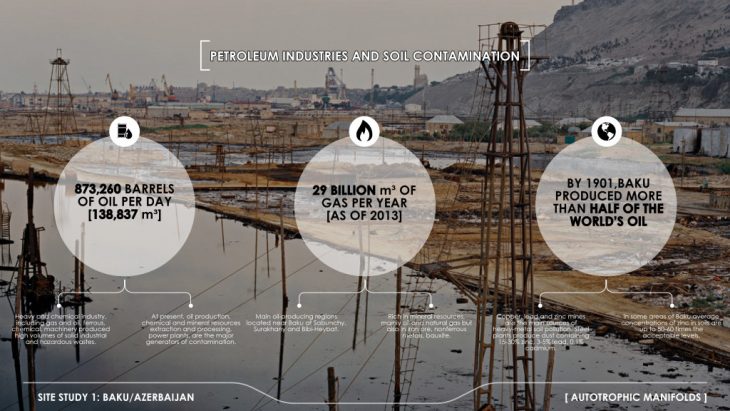
‘A site-by-site approach that takes into account the individual environmental characteristics of soils and human activities is essential: each site has a unique risk profile, a unique chemistry and a unique history. ’ ( Science for Environment Policy, 2012)
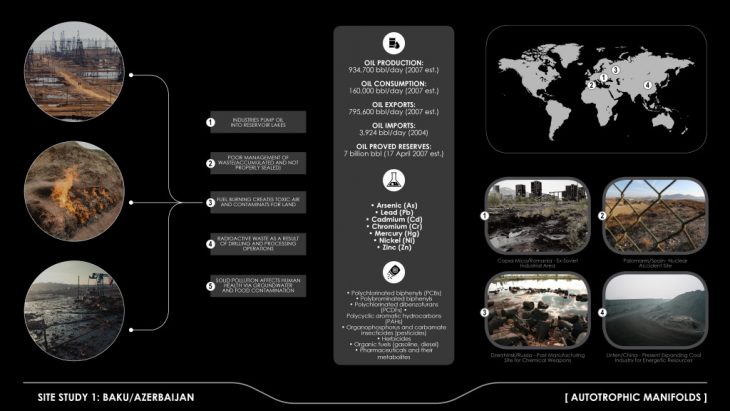
80 percent of the world’s wastewater is dumped—largely untreated—back into the environment, polluting rivers, lakes, and oceans. Our drinkable water sources are finite: Less than 1 percent of the earth’s freshwater is actually accessible to us. Without action, the challenges will only increase by 2050, when global demand for freshwater is expected to be one-third greater than it is now.
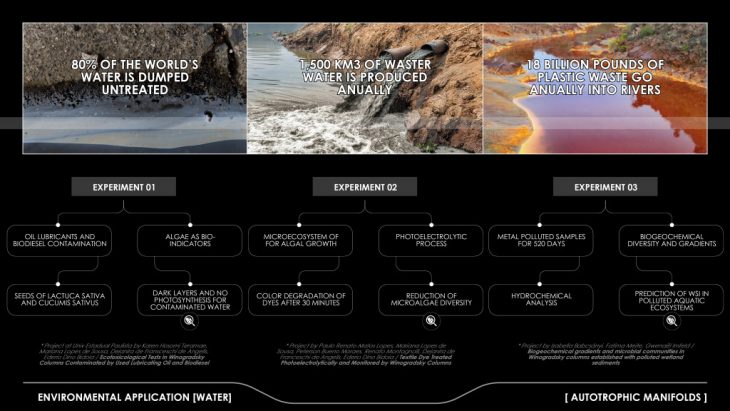
Water pollution occurs when harmful substances—often chemicals or microorganisms—contaminate a stream, river, lake, ocean, aquifer, or other body of water, degrading water quality and rendering it toxic to humans or the environment. Water is uniquely vulnerable to pollution. Known as a “universal solvent,” water is able to dissolve more substances than any other liquid on earth. Toxic substances from farms, towns, and factories readily dissolve into and mix with it, causing water pollution.
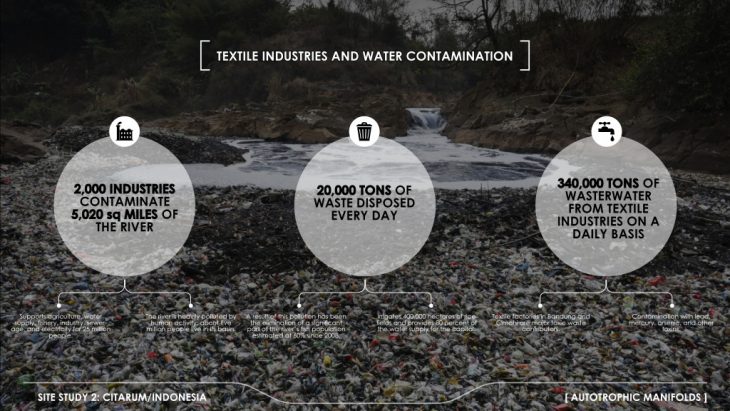
Case Study 2: Citarum River, West-Java/Indonesia
The Citarum River (Sundanese: Walungan Citarum) is the longest and largest river in West Java, Indonesia. It has an important role in the life of the people of West Java, as it supports agriculture, water supply, fishery, industry, sewerage, and electricity for 25 million people. It has been called one of the most polluted rivers in the world.As Indonesia’s most strategic river, the Citarum is the source of water for the Jatiluhur Reservoir, which is Indonesia’s largest reservoir at 3 billion cubic meters of storage capacity. The reservoir not only supplies clean water for Bandung but also provides 80 percent of the water supply for the capital. It also irrigates 400,000 hectares of rice fields and is a source of energy for three hydroelectric power stations serving three cities.Yet a study conducted by the Blacksmith Institute in 2013 found that levels of lead in the Citarum River reached 1,000 times worse than the U.S. standards for drinking water.
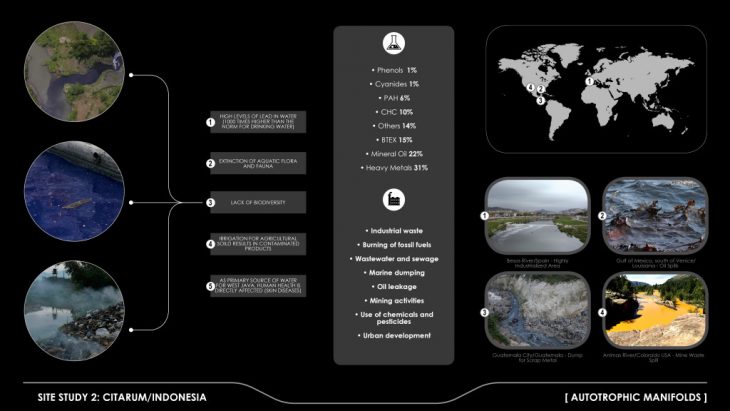
02.MICROBIAL SYSTEMS | THE WINOGRADSKY ECOSYSTEMS
For many years, microbial systems have been a focus point for scientists in the constant pursue of a bio-integrated design that implements novel methodologies and materials based on adaptive, responsive and performative behaviors. Within the context of the built environment, the main challenge is the translation of these products at a larger scale, that would not affect the output performance, given the fact that microorganisms and biological matter are often easily disrupted by environmental changes or other pathogenic factors within their medium.
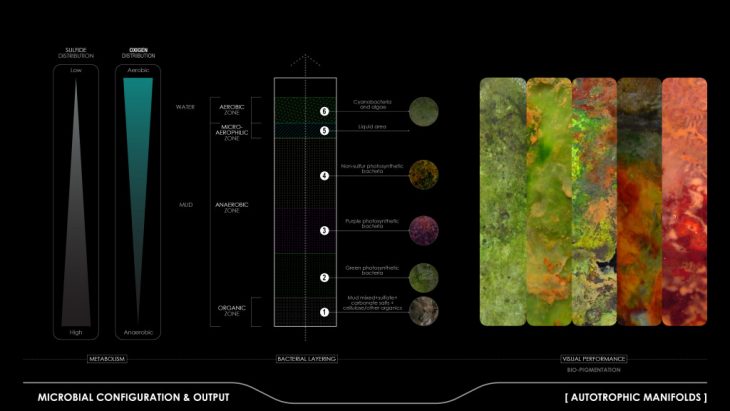
The Winogradsky experiment represents a unique microbial system, considered a fascinating, yet not fully understood component within the filed of microbiology. Winogradsky columns are enrichment cultures, typically made by filling transparent cylinders with soil or sediment and incubating in light.
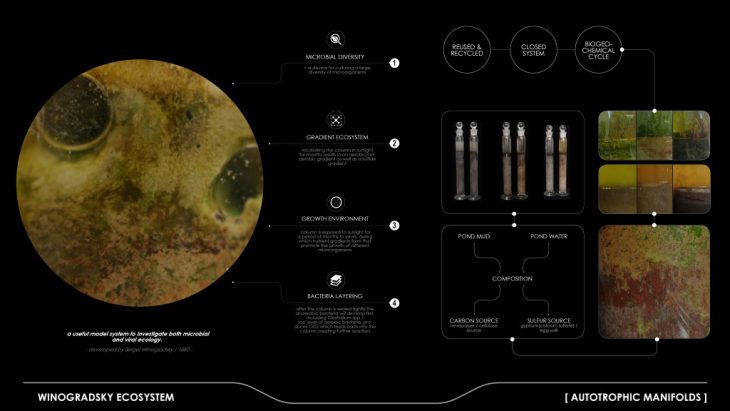
Over time, microbial activity and abiotic processes result in chemical and environmental gradients from top to bottom and surface to interior of the columns, resulting in diverse niches for microbial growth. Light serves as the energy source for primary producers and a structured microbial ecosystem develops in which all the necessary processes occur to maintain nutrient cycling.
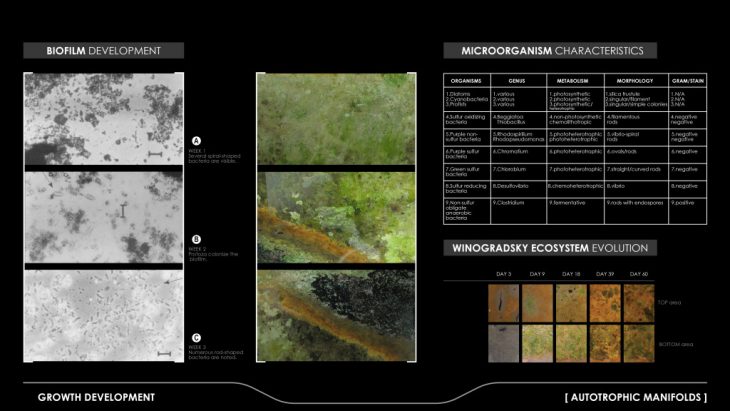
03.AUGMENTATION OF MICROBIAL CONFIGURATIONS | WINOGRADSKY 2.0
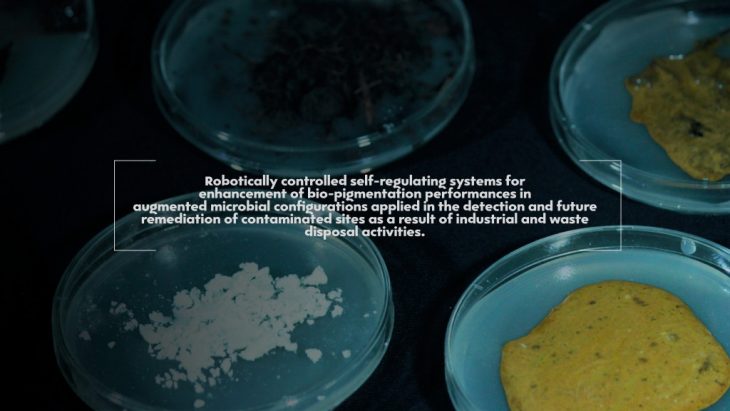
The scientific experimental stages follows the set-up of a series of small scale Winogradsky columns with the aim of observing basic behavior and further augmenting the formula for optimization of identified bio-parameters. The first experiment looked at the incubation of 10 columns, using the existing formulas for the Winogradsky ecosystems. In this case, the water and pond samples were collected from Parc de la Ciutadella in Barcelona and incubated both as an individual medium but also as cross-mediums. The carbon source used was newspaper and the sulfur source was egg yolk. As a result after 2 months of incubation and observation, half of the columns showed a dark layering suggesting the presence of an intense metabolic process. Nonetheless, the dark bio-pigmentation signaled a lack or minimal presence of base bacterial communities in the collected soil samples or a lack of nutritive addition.
The second part of experimental stage started as an optimization of stage 1 parameters: achieving a dense/diverse and bright bio-pigmentation and a faster time of incubation. For this, 50 samples were set-up, each set of 10 exploring a different water/soil base and a different quantitative addition of nutrients such as Lacto Acidophilus, Calcium Carbonate, Calcium Sulfate and Iron Oxide.
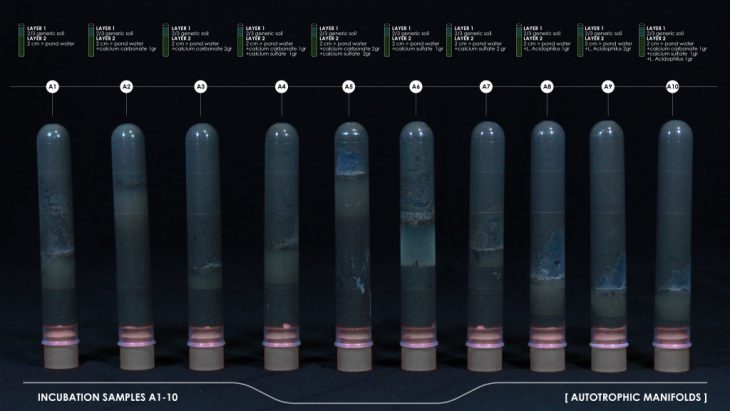
SAMPLES A1-10: generic soil + pond water
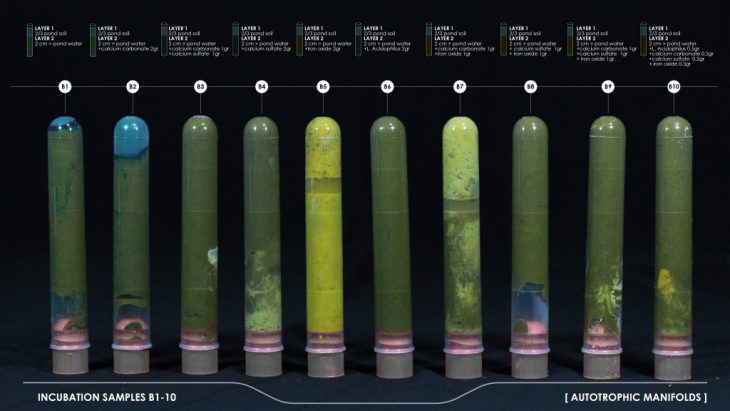
SAMPLES B1-10: pond soil + pond water
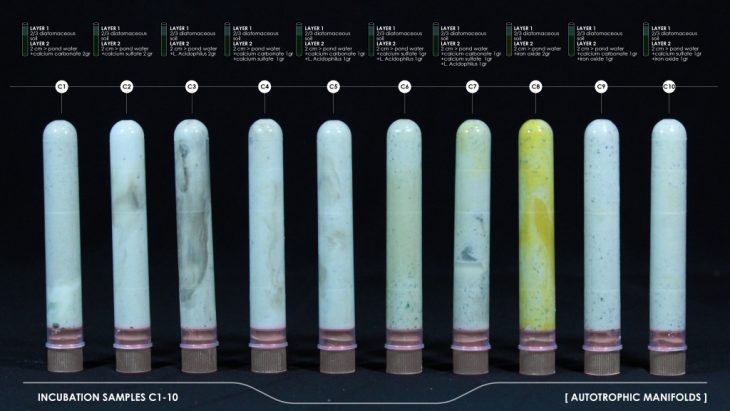
SAMPLES C1-10: diatomaceous soil + pond water
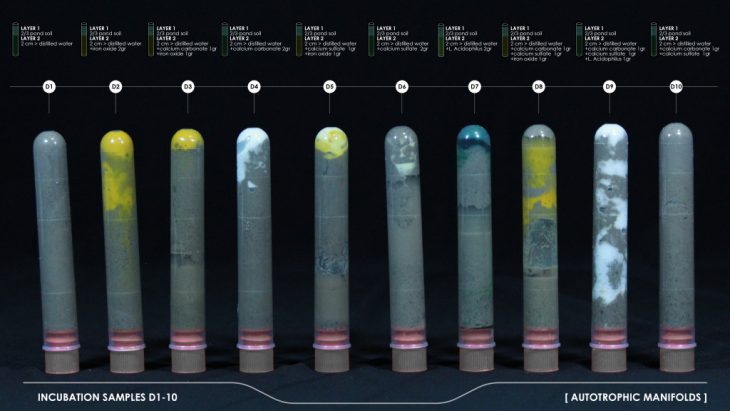
SAMPLES D1-10: pond soil + distilled water
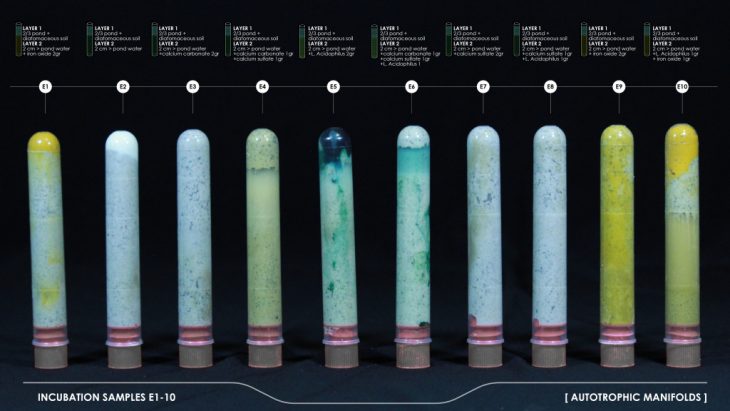
SAMPLES E1-10: pond soil + diatomaceous soil + pond water
The following data and results were extracted from these samples:
-Incubation process is boosted by a constant presence of a light source (natural light + extra artificial light) and at higher temperatures (which is provided by a source of artificial light)
-Pond water and pond soil as base mediums showed the first results in terms of bio-pigmentation
-Diatomaceous earth showed results as a cross-combination with pond soil, not as an individual base
-Addition of nutrients works based in a 2gr ration per additive when introduced as a singular nutrients or a maximum of 1gr when combined with various other nutrients
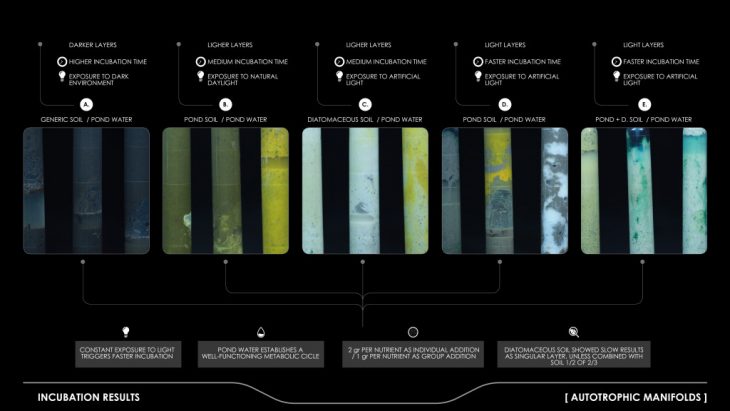
04. MICROBIAL CONFIGURATIONS FOR ECOLOGICAL UTILIZATION | CONTAMINATION DETECTION AND REMEDIATION
As a result of the complex metabolic cycle, the Winogradsky columns have been investigated as potential solutions of certain environmental applications such as: plastic degradation, growth environment for uncultivable microorganisms or alternative sources of energy. Recent studies show the potential of the Winogradsky experiments within the field of contamination detection and remediation. With few studies available, the data highlights strategies such as algal investigation and automated monitoring for detection of heavy metals in soils and sediments as well as breaking down certain textile dyes.
05.DESIGNING WITH A LIVING COMPONENT | SHAPE FINDING AND ROBOTIC 3D PRINTING
In terms of design implementation, the project looks at redefining both esthetically and functionally the Winogradsky columns, by 3d printing with plastic based filaments new incubation mediums for the performative samples previously described. For this, the process aims to use robotic additive manufacturing for a faster print time, possibility of using different plastic base materials with temperature controls (for optimizing translucency for bio-pigmentation), meanwhile challenging the optimization of complex geometries as water-resistance mediums for bacterial incubation at a larger scale. The first tests conducted were based on simple geometries that follow a vertical direction and a small/medium scale for incubation one samples and identifying the behavior of a Winogradsky column within different shapes. The results showed that geometry is not a major influence in terms of bio-performance, but the ratio of the geometry can be main indicators in term of directing and highlight the areas with specific bio-pigmentation aggregation.
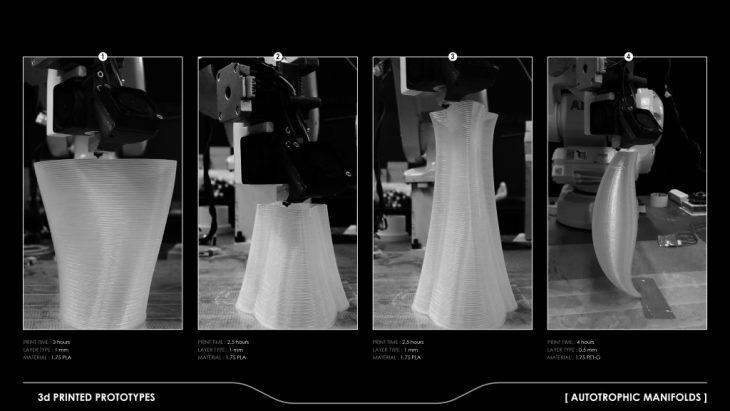
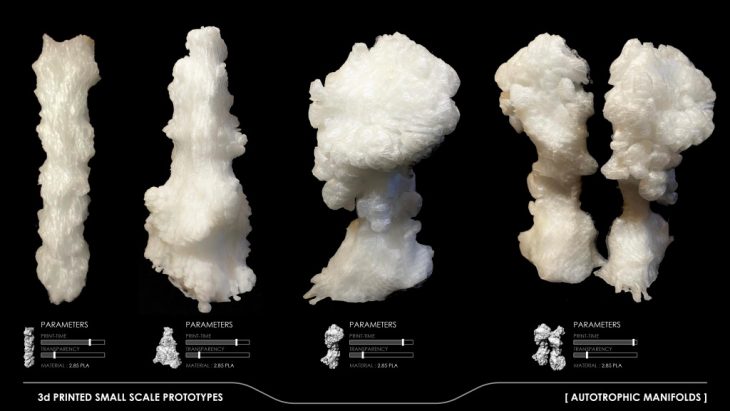
Following these results, the design stage moves towards digital simulation of complex shapes, inspired by organic differential growth in bacterial configurations. The process id developed using Houdini and is based on growth along a designated curvature and volume that represents both a geometrical and microbial scenario for enhancing or increasing/decreasing certain areas within the Winogradsky column. Five scenarios are set-up and for each of this scenarios 50 shape iterations are generated as well as a simulation of advection growth with a volume limit of maximum 5 liters of matter per shape.
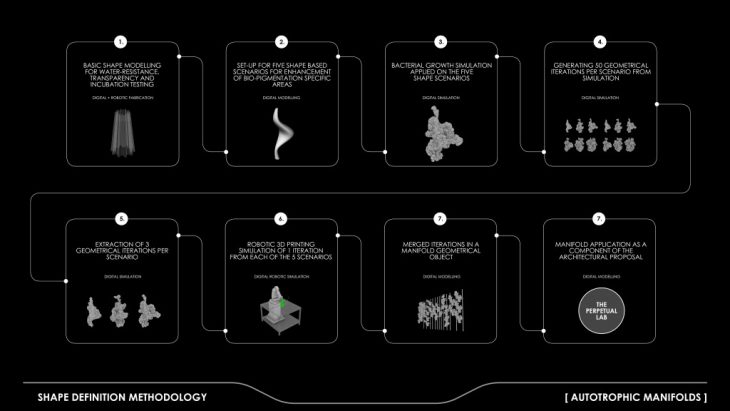
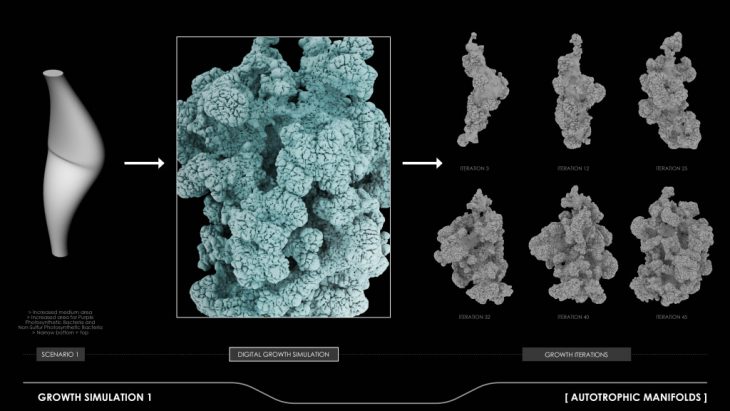
SCENARIO 1_ Increased area for Purple Photosynthetic Bacteria and Non-Sulfur Photosynthetic Bacteria
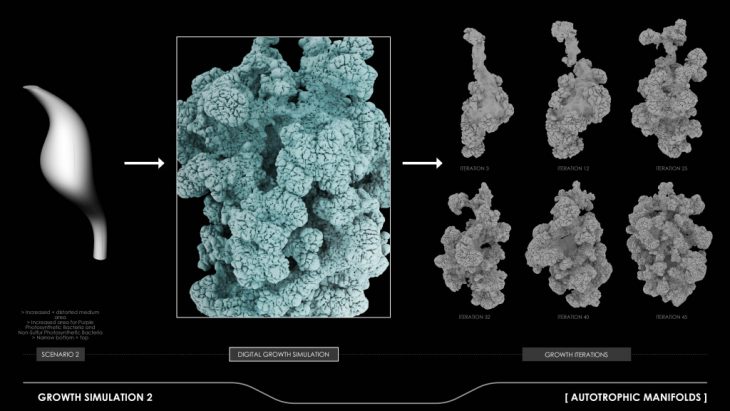
SCENARIO 2_ Increased area for Purple Photosynthetic Bacteria and Non-Sulfur Photosynthetic Bacteria
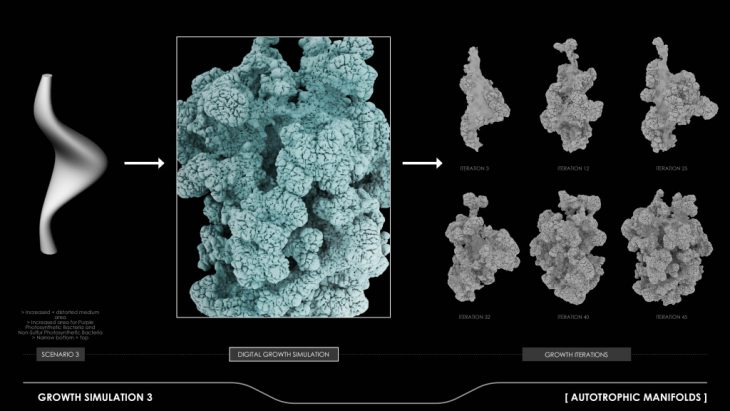
SCENARIO 3_ Increased area for Purple Photosynthetic Bacteria and Non-Sulfur Photosynthetic Bacteria
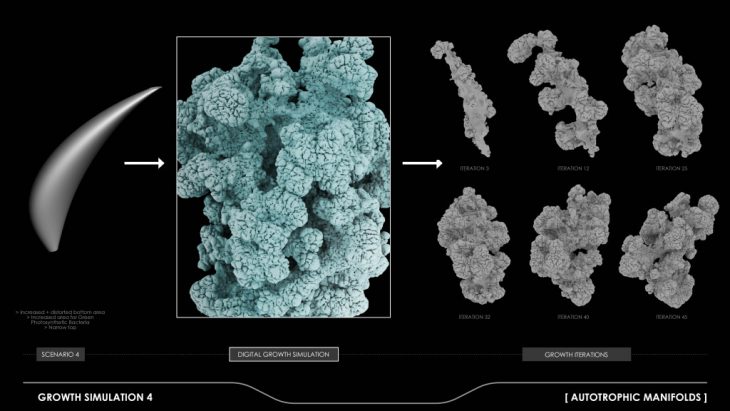
SCENARIO 4_ Increased area for Green Photosynthetic Bacteria

SCENARIO 5_ Increased area for Green Photosynthetic Bacteria and Cyanobacteria
As a result, one iteration for each scenario is simulated for robotic 3d printing in order to identify a maximum scale and possible shape complexity in term of pixelization. In this case, the manufacturing process should start with iterations 1-20 for testing precision and water-resistance and increase the complexity further to iteration 30-40, which contain a higher area of shape aggregation, therefore generating more advanced geometries, but less uniform.
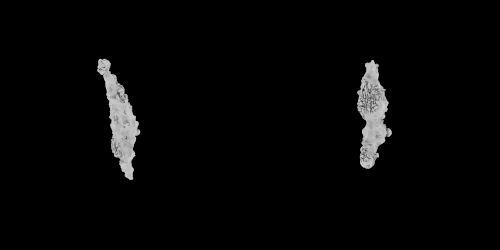
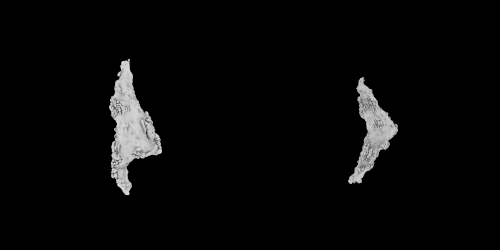
The next design step focuses on merging the individual modules into one manifolds that can rotate at a 360 degree angle and move vertically, for allowing an easier maintenance systems as well as a dynamic configuration that can change.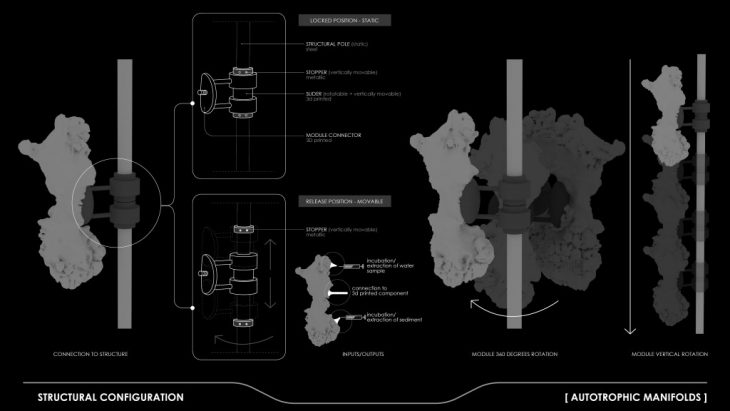
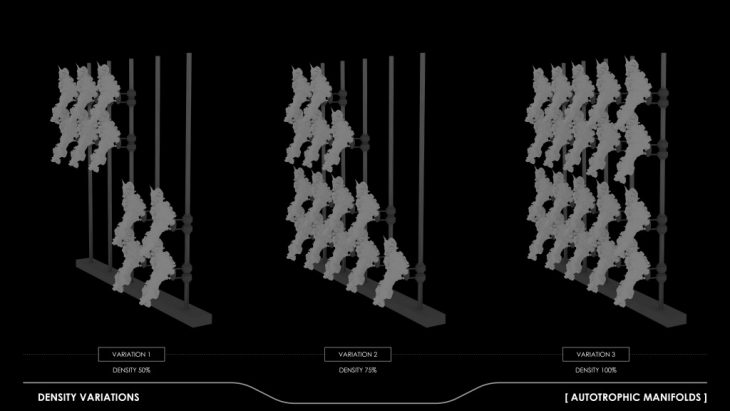

06. THE PERPETUAL LAB | AN ARCHITECTURE WITH/FOR MICROBIAL ECOLOGIES
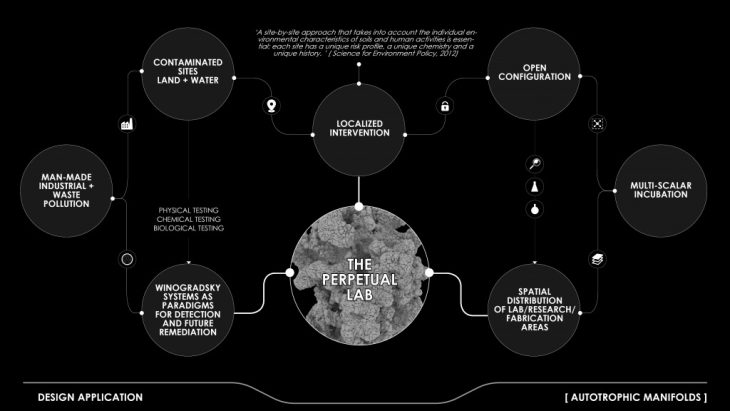
The architectural application investigates the potential of a decentralized network of scientifically oriented structures that explore an on-site approach towards the bio-development and implementation of the Winogradsky manifolds as systems for detection of contaminated land/water samples and future remediation at a larger scale, through an aggregation of manifolds throughout the contaminated landscape. 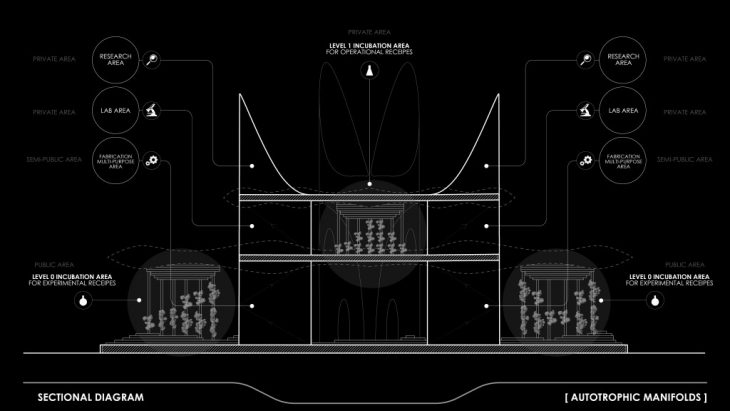

The Perpetual Lab is a space of science, dedicated towards embracing the research and application of microbial systems on a large and dynamic scale within a contaminated site, therefore generating a bio integrated architecture that pursues a methodology based on metabolic microbial networks.
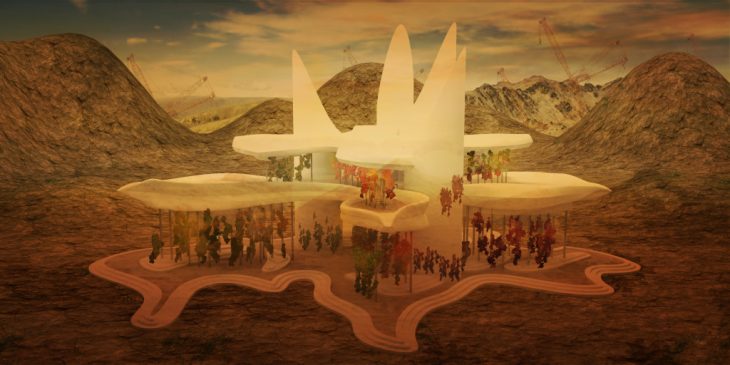
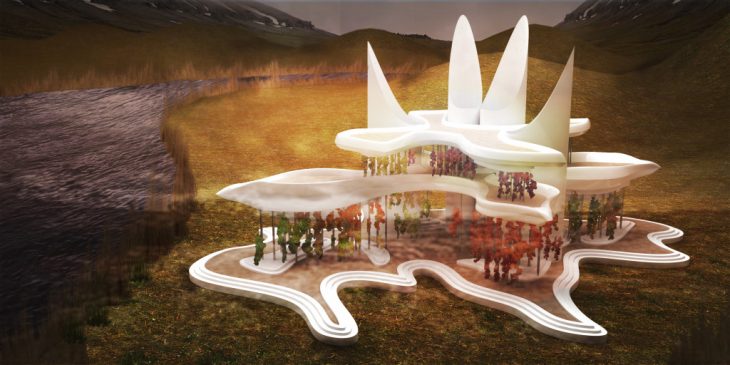
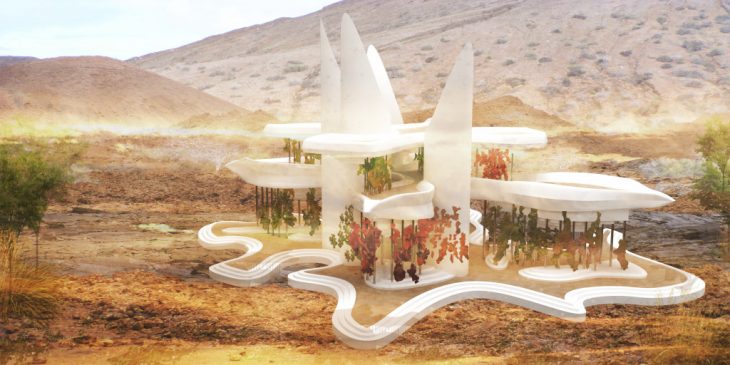
AUTOTROPHIC MANIFOLDS is a project developed at IaaC, Institute for Advanced Architecture of Catalonia, developed at Master in Advanced Architecture 2019/20 by:
Student: Daria Ciobanu-Enescu
Faculty: Marcos Cruz, Kunal Chadha
Biology Support: Nuria Conde Pueyo
Thesis Studio: C-Biom.A